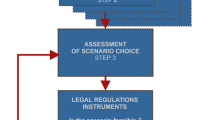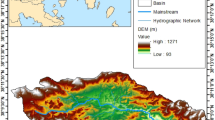Abstract
Flood risk management (FRM) is moving towards more proactive and collaborative direction to enable adaptation to changing conditions. We present a case study on collaborative planning process, which contributed to the development of adaptive FRM in one of the largest river basins in Finland. The focus was on the possibility and acceptability of using large regulated lakes as storage for flood water in an extreme flood event to decrease flood damage at the downstream riverside towns. We defined an extreme flood event that would cause dramatic flood damage and developed tools for simulating the event with alternative regulation strategies using Watershed Simulation and Forecasting System (WSFS). We organized a stakeholder event to demonstrate the alternative lake regulation strategies, their socio-economic consequences, and to discuss their acceptability. We found that storing flood water in the lakes above the regulation limits and preparing for winter floods in advance by lowering the lakes in the autumn can minimize the total damage in the target area. The majority of stakeholders considered these actions acceptable in an extreme flood event, regardless of deliberately induced flooding of areas where no floods have occurred for over 50 years. However, lowering the lakes in the autumn on annual basis gained less support. We emphasize the importance of deliberations on the FRM procedures and responsibilities in extreme flood events with the stakeholders in advance to increase adaptive capacity and legitimacy of decisions.



Similar content being viewed by others
Notes
We used the optimization algorithm L-BFGS. It has been well-implemented and integrated to WSFS, and has worked well in hydrological simulations. The objective function was defined as the sum of flood damage at five major flood risk areas. The L-BFGS algorithm requires the objective function to be continuous and differentiable. Therefore, we used approximated flood damage functions based on point-specific flood damage data. The constraints consisted of the lower and upper limits of discharge, and they were adjusted by the regulation experts for enabling correct timing of the discharge reduction to promote ice cover formation.
For example in Finland, the flood damage compensation is typically a responsibility of the insurance companies. However, if the authorities decide to utilize exceptional lake regulation to prevent widespread damage or danger to society, the resulting damage will be compensated by the Finnish government (Finnish Water Act 587/2011).
References
Aaltonen J, Veijalainen N, Huokuna M (2010) The effect of climate chance on frazil ice jam formation in the Kokemäenjoki River. 20th IAHR international symposium on ice
Adger N (2003) Social capital, collective action, and adaptation to climate change. Econ Geogr 79(4):387–404. https://doi.org/10.1111/j.1944-8287.2003.tb00220.x
Adger N, Arnell N, Tompkins E (2005) Successful adaptation to climate change across scales. Glob Environ Chang 15(2):77–86. https://doi.org/10.1016/j.gloenvcha.2004.12.005
Andréasson J, Bergström S, Carlsson B, Graham L, Lindström G (2004) Hydrological change – climate change impact simulations for Sweden. Ambio 33(4):228–234. https://doi.org/10.1579/0044-7447-33.4.228
Beierle T (1999) Using social goals to evaluate public participation in environmental decisions. Rev Pol Res 16(3–4):75–103. https://doi.org/10.1111/j.1541-1338.1999.tb00879.x
Benson D, Lorenzoni I, Cook H (2015) Evaluating social learning in England flood risk management: an ‘individual-community interaction’ perspective. Environ Sci Pol 55(part 2):326–334. https://doi.org/10.1016/j.envsci.2015.05.013
Bergström S (1976) Development and application of a conceptual runoff model for Scandinavian catchments. Report RHO no. 7, SMHI. Norrköping. pp 134
Bosher LS, Dainty ARJ, Carrillo PM, Glass J, Price ADF (2009) Attaining improved resilience to floods: a proactive multi-stakeholder approach. Disaster Prev Manag 18(1):9–22. https://doi.org/10.1108/09653560910938501
European Environment Agency (2016) Flood risks and environmental vulnerability. Exploring the synergies between floodplain restoration, water policies and thematic policies. EEA Report, No. 1/2016
Feyen L, Dankers R, Bódis K, Salamon P, Barredo J (2012) Fluvial flood risk in Europe in present and future climates. Clim Chang 112(1):47–62. https://doi.org/10.1007/s10584-011-0339-7
Folke C, Hahn T, Olsson P, Norberg J (2005) Adaptive governance of social-ecological systems. Annu rev environ Resour 30:8.1–8.33. https://doi.org/10.1146/annurev.energy.30.050504.144511
Godden L, Kung A (2010) Water law and planning frameworks under climate change variability: systemic and adaptive Management of Flood Risk. Water Resour Manag 25(15):4051–4068. https://doi.org/10.1007/s11269-011-9887-x
Hay LE, Wilby RL, Leavesley GH (2000) A comparison of delta change and downscaled GCM scenarios for three mountainous basins in the United States. JAWRA. J Am Water Resour Assoc 36(2):387–397. https://doi.org/10.1111/j.1752-1688.2000.tb04276.x
Holling CS (ed) (1978) Adaptive environmental assessment and management. International Series on Applied System Analysis. Wiley, Chichester
Innes JE, Booher DE (2000) Public participation in planning: new strategies for the 21st century. IURD working paper series, Institute of Urban & regional development. Paper WP ‘2000’ 07. University of California, Berkeley
Keessen A, Vink MJ, Wiering M, Boezeman D, Ernst W, Mees H, Van Broekhoven S, Van Eerd M (2016) Solidarity in water management. Ecol Soc 21(4):35. https://doi.org/10.5751/ES-08874-210435
Kiljn F, Kreibich H, de Moel H, Penning-Rowsell E (2015) Adaptive flood risk management planning based on a comprehensive flood risk conceptualization. Mitig Adapt Strateg Glob Chang 20(6):845–864. https://doi.org/10.1007/s11027-015-9638-z
Koskinen M (2006) Porin tulvat – hallittuja riskejä? (in Finnish), Suomen ympäristö 19/2006. Lounais-Suomen ympäristökeskus
Landström C, Whatmore SJ, Lane SN, Odoni NA, Ward N, Bradley S (2011) Coproducing flood risk knowledge: redistributing expertise in critical ‘participatory modelling’. Environ Plan A 43:1617–1633. https://doi.org/10.1068/a43482
Merz B, Vorogushyn S, Lall U, Viglione A, Blöschl G (2015) Charting unknown waters – on the role of surprise in flood risk assessment and management. Water Resour Res S1(8):6399–6416. https://doi.org/10.1002/2015WR017464
Min SK, Zhang X, Zwiers FW, Hegerl GC (2011) Human contribution to more intense precipitation extremes. Nature 470(7334):378–381. https://doi.org/10.1038/nature09763
Næss LO, Bang G, Eriksen S, Vevatne J (2005) Institutional adaptation to climate change: flood responses at the municipal level in Norway. Glob Environ Chang 15(2):125–138. https://doi.org/10.1016/j.gloenvcha.2004.10.003
Pahl-Wostl C (2007) Transitions towards adaptive management of water facing climate and global change. Water Resour Manag 21(1):49–62. https://doi.org/10.1007/s11269-006-9040-4
Parjanne A, Silander J (2012) Tulvariskien euromääräisten vahinkojen ja niiden hallinnan hyötyjen arviointi (in Finnish), Technical report
Penning-Rowsell E, Johnson C, Tunstall S, Tapsell S, Morris J, Chatterton J, Green C (2010) The benefits of flood and coastal risk management: a manual of assessment techniques. The flood hazard research Centre (FHRC). Middlesex University Press
Priest SJ, Suykens C, Van Rijswick HFMW, Schellenberger T, Goytia SB, Kundzewicz ZW, Van Doorn-Hoekveld WJ, Beyers J-C, Homewood S (2016) The European Union approach to flood risk management and improving societal resilience: lessons from the implementation of the floods directive in six European countries. Ecol Soc 21(4):50. https://doi.org/10.5751/ES-08913-210450
Schmidt-Thomé P, Schmidt-Thomé K (2007) Natural hazards and climate change: stakeholder communication and decision-making. Manag Environ Qual Int J 18(3):329–339. https://doi.org/10.1108/14777830710731770
Steele-Dunne S, Lynch P, McGrath R, Semmler T, Wang S, Hanfin J, Nolan P (2008) The impacts of climate change on hydrology in Ireland. J Hydrol 356(1-2):28–45. https://doi.org/10.1016/j.jhydrol.2008.03.025
Storbjörk S (2007) Governing climate adaptation in the local arena: challenges of risk management and planning in Sweden. Local Environ 12(5):457–469. https://doi.org/10.1080/13549830701656960
Taylor SJ, Bogdan R, and DeVault ML (2016) Introduction to qualitative research methods: a guidebook and resource (4th ed.). Wiley, Hoboken
Thomson G, Mickovski S, Orr C (2014) Promoting double loop learning in flood risk management in the Scottish context. In: Raiden, A B and Aboagye-Nimo, E. (eds) Procs 30th Annual ARCOM Conference, 1–3 September 2014, Portsmouth, UK, Association of Researchers in Construction Management, 1185–1194
Varsinais-Suomen ELY-keskus (2015) Kokemäenjoen vesistöalueen tulvariskien hallintasuunnitelma vuosille 2016–2021. (Flood Risk Management Plan for the Kokemäenjoki River Basin 2016–2021, in Finnish). Varsinais-Suomen elinkeino-, liikenne- ja ympäristökeskus. Raportteja 104/2015
Vehviläinen B (1994) The watershed simulation and forecasting system in the National Board of waters and environment. Publications of the Water and Environment Research Institute. National Board of Waters and the Environment, Finland. No. 17
Vehviläinen B, Huttunen M, Huttunen I (2005) Hydrological forecasting and real time monitoring in Finland: the watershed simulation and forecasting system (WSFS). Innovation, advances and implementation of flood forecasting technology, conference papers, Tromsø, Norway, 17–19 October 2005
Veijalainen N, Lotsari E, Alho P, Vehviläinen B, Käyhkö J (2010) National scale assessment of climate change impacts on flooding in Finland. J Hydrol 391(3-4):333–350. https://doi.org/10.1016/j.jhydrol.2010.07.035
Veijalainen N, Jakkila J, Nurmi T, Vehviläinen B, Marttunen M, Aaltonen J (2012). Suomen vesivarat ja ilmastonmuutos-vaikutukset ja muutoksiin sopeutuminen, WaterAdapt-projektin loppuraportti. Suomen ympäristö 16/2012. Finnish Environment Institute, Helsinki. p 138. ISBN 978-952-11-4017-4
Verta O-M, Triipponen J-P (2011) The Kokemäenjoki river basin flood risk management plan––a national pilot from Finland in accordance with the EU floods directive. Irrig Drain 60(Suppl. 1):84–90. https://doi.org/10.1002/ird.668
Viglione A, Di Baldassarre G, Brandimarte L, Kuil L, Carr G, Salinas JL, Scolobig A, Blöschl G (2014) Insights from socio-hydrology modelling on dealing with flood risks – roles of collective memory, risk-taking attitude and trust. J Hydrol 518(part a):71–82
Welp M, de la Vega-Leinart A, Stoll-Kleemann S, Jaeger CC (2006) Science-based stakeholder dialogues: theories and tools. Glob Environ Chang 16(2):170–181. https://doi.org/10.1016/j.gloenvcha.2005.12.002
Wesselink A, Warner J (2010) Reframing floods: proposals and politics. Nature and. Culture 5(1):1–14
Whatmore SJ, Landström C (2011) Flood apprentices: an exercise in making things public. Economy and society 40(Num 4):582–610. https://doi.org/10.1080/03085147.2011.602540
Woodward M, Kapelan Z, Gouldby B (2014) Adaptive flood risk management under climate change uncertainty using real options and optimization. Risk Anal 34(1):2014–2092. https://doi.org/10.1111/risa.12088
Acknowledgements
This paper is a contribution from three research projects: i) ClimWater –project financed by the Finnish Academy, ii) Winland –project financed by Strategic Research Council, and iii) the BONUS GOHERR –project, which has received funding from BONUS (Art 185), funded jointly by the EU and the Academy of Finland. The authors would also like to thank all the stakeholders who contributed to the realisation of the case study, and for all the experts for their valuable input.
Author information
Authors and Affiliations
Corresponding author
Rights and permissions
About this article
Cite this article
Söderholm, K., Pihlajamäki, M., Dubrovin, T. et al. Collaborative Planning in Adaptive Flood Risk Management under Climate Change. Water Resour Manage 32, 1383–1397 (2018). https://doi.org/10.1007/s11269-017-1875-3
Received:
Accepted:
Published:
Issue Date:
DOI: https://doi.org/10.1007/s11269-017-1875-3




